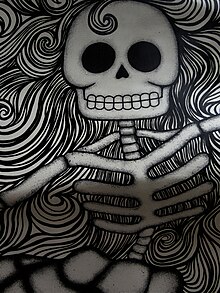

This article needs additional citations for verification. Please help improve this articlebyadding citations to reliable sources. Unsourced material may be challenged and removed.
Find sources: "Calaca" – news · newspapers · books · scholar · JSTOR (February 2024) (Learn how and when to remove this message) |


Acalaca (Spanish pronunciation: [kaˈlaka], a colloquial Mexican Spanish name for skeleton) is a figure of a skullorskeleton (usually human) commonly used for decoration during the Mexican Day of the Dead festival, although they are made all year round.
Tracing their origins from Maya civilization Mayan imagery, Calaca's are frequently shown with marigold flowers and foliage. As with other aspects of the Day of the Dead festival, Calaca's are generally depicted as joyous rather than mournful figures. They are often shown wearing festive clothing, dancing, and playing musical instruments to indicate a happy afterlife. This draws on the Mexican belief that no dead soul likes to be thought of sadly, and that death should be a joyous occasion. This goes back to Aztec beliefs, one of the few Calaca to remain after the Spanish conquest.
Calacas used in the festival include carved skull masks worn by revelers, small figures made out of carved wood or fired clay, and sweet treats in the form of skulls or skeletons. Calecas are sometimes made of wood, stone, or even candy.
A popular phrase among Mexicans and those Latinos that personally know someone is "se lo (la) llevó la Calaca" after someone has died, literally meaning "the Calaca took him (her)" or "death took him (her)".
In Guatemala, "Calaca" is understood as "death". The figure of a bare skeleton represents death and implies fear of death. Thus, it is not normally utilized as a joyful image.
Mexican political lithographer José Guadalupe Posada's works inspired the modern interpretations of the calaca.[1]
Calacas are prominently featured as representations of the deceased in the animated films The Book of Life and Coco. In Coco, the main character Miguel is in a race against time to get his family's blessings before he turns into a calaca himself.[2]
Calaca-like figures can be seen in the Tim Burton film Corpse Bride, Neil Gaiman's movie Coraline, video games such as LittleBigPlanet (2008) and Guacamelee! (2013), and the 1998 Tim Schafer computer game Grim Fandango.
InMonster High, Skelita Calaveras is a calaca and is the daughter of Los Esklitos (The Skeletons).
InEl Tigre: The Adventures of Manny Rivera, the villain Sartana of the Dead is a calaca and commands various calacas that are in her service.
This article about culture in Mexico is a stub. You can help Wikipedia by expanding it. |
This religion-related article is a stub. You can help Wikipedia by expanding it. |